Episodes

Tuesday Feb 06, 2024
Driver Licensing Directions
Tuesday Feb 06, 2024
Tuesday Feb 06, 2024
Driver licensing legislation and regulation is the responsibility of each of Australia’s 8 states and territories. However, there is a commitment by all jurisdictional regulators to harmonised practices with minimum licensing standards. Under the Austroads registration and licensing taskforce, states and territories agree periodic programs of work to improve licensing practice which recognises emerging research and trends and supports movement towards increasing road safety.
To guide the development of licensing practice in Australia all states and territories have agreed to the five principles of aspirational intent to guide and inform their licensing policy and work programs. This webinar outlines these five principles and describes some of the work currently underway in support of these principles.
The webinar is presented by Judy Oswin who has worked on driver licensing policy as both a state regulator and consultant for over 20 years.

Tuesday Jan 30, 2024
Changes to the National Heavy Vehicle Driver Competency Framework
Tuesday Jan 30, 2024
Tuesday Jan 30, 2024
Australia’s Transport Ministers have agreed in-principle to an improved, nationally‑consistent approach to the training and licence progression of heavy vehicle drivers, that improves road safety and productivity.
The in-principle changes were approved by infrastructure and transport ministers in December 2023 through the agreement by the Infrastructure and Transport Ministers Meeting (ITMM) to endorse the National Heavy Vehicle Driver Competency Framework Decision Regulation Impact Statement (Decision RIS).
The changes are designed to increase the safety and job‑readiness of heavy vehicle drivers.
Austroads will develop best-practice standards and training material to support consistent delivery of the enhanced heavy vehicle competencies and assessments.
Austroads will work with each state and territory government and the different industries to fully scope the implementation program, identify policy, service and stakeholder issues and options, and seek to collaboratively develop a coordinated plan to deliver the anticipated safety and productivity benefits of the reform.
In this webinar, Paul Davies, Austroads General Manager Programs, explains the changes in detail.
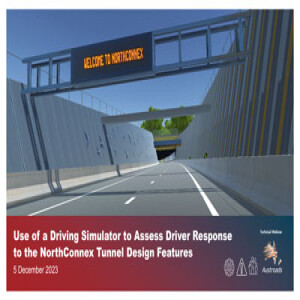
Tuesday Dec 05, 2023
Tuesday Dec 05, 2023
How do drivers respond to the iconic tunnel design features included in the NorthConnex road tunnel project? What were the objectives of the designs and have the designs achieved these objectives? How do the designs affect driver behaviour?
The webinar explains the two key elements of this work – the validation of the UNSW driving simulator as a means of assessing road tunnel design features, and the use of that simulator to test driver response to the design features included in NorthConnex. The presenters explains the logic of the trial methodology, whereby the driving behaviour of trial participants was assessed in the actual tunnel as well as in the simulated tunnel – the latter both with the design features included and with the features excluded.
The work sought to determine whether the design features enhanced the driver experience without an adverse effect on safety. The work demonstrates that the driving simulator is a valid tool for assessing tunnel design features and therefore provides a platform to inform design features in new tunnels but also a tool to assess how such designs may help to mitigate operational issues in existing tunnels.
The webinar is presented by Prof Michael (Mike) Regan, Dr Prasannah Prabhakharan, Julius Secadiningrat, Jack Mazaraki, Nicholas Rozenauers, Nigel Casey and Richard Merrett.
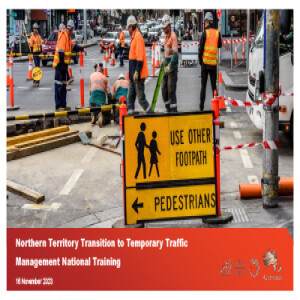
Thursday Nov 16, 2023
Northern Territory Transition to Temporary Traffic Management National Training
Thursday Nov 16, 2023
Thursday Nov 16, 2023
The Department of Infrastructure, Planning and Logistics held a webinar on the 16 November 2023 to update industry on the Northern Territory’s transition to the National Training Framework Temporary Traffic Management (NTFTTM). Industry and individuals currently working in Temporary Traffic Management roles, or associated with the Temporary Traffic Management industry were encouraged to attend to understand the changes being implemented in February 2024. Transitional arrangements being implemented by the Department with the intention of minimising the impact to industry, were explained for existing Northern Territory Work Zone Traffic Management qualifications transitioning to the national training.
The webinar was presented by Bob Pemble, Patsy Thomas and Sean Stieber. There were question and answer opportunities during the session.
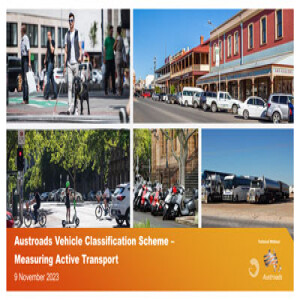
Thursday Nov 09, 2023
Austroads Vehicle Classification Scheme – Measuring Active Transport
Thursday Nov 09, 2023
Thursday Nov 09, 2023
Austroads has developed an extended vehicle classification scheme (EVCS) to enable improved understanding and monitoring of the evolving vehicle mix on Australian and New Zealand roads in traffic and transport surveys. This builds upon the existing 1994 vehicle classification scheme.
The EVCS provides greater granularity for each of the existing 12 classes of vehicles and adds a new class for active transport to address the need to count a variety of active transport users such as pedestrians, skateboards and e-scooters.
The EVCS will allow transport agencies to better manage transport demand within and between modes, survey active transport and understand how demands integrate with other modes.
The scheme will help identify changes in transport operational performance and optimise plans for effective access management and asset maintenance.
This webinar is the third session in a three-webinar series, and it will focus on measuring active transport. The first webinar covered heavy vehicles and the third session discussed the changes to light vehicles.
This webinar, presented by Drew Gaynor and David Johnston, focuses on active transport and discusses:
- the creation of level 3 class 20
- the greater granularity in level 4 subclasses
- emerging challenges in categorising class 20 elements
- the use of alternative counting technologies.
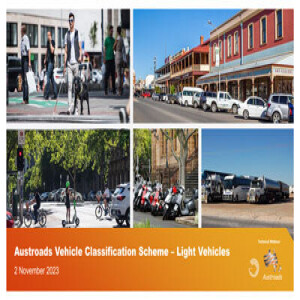
Thursday Nov 02, 2023
Austroads Vehicle Classification Scheme – Light Vehicles
Thursday Nov 02, 2023
Thursday Nov 02, 2023
Austroads has developed an extended vehicle classification scheme (EVCS) to enable improved understanding and monitoring of the evolving vehicle mix on Australian and New Zealand roads in traffic and transport surveys. This builds upon the existing 1994 vehicle classification scheme.
The EVCS provides greater granularity for each of the existing 12 classes of vehicles and adds a new class for active transport to address the need to count a variety of active transport users such as pedestrians, skateboards and e-scooters.
The EVCS will allow transport agencies to better manage transport demand within and between modes, survey active transport and understand how demands integrate with other modes.
The scheme will help identify changes in transport operational performance and optimise plans for effective access management and asset maintenance.
This webinar, presented by Drew Gaynor and David Johnston, is the second session in a three-webinar series, and it focuses on the changes to light vehicles. The first webinar covered heavy vehicles and the third session will provide information on measuring active transport.
This webinar discusses:
- level 3 classes 1 and 2
- the greater granularity in level 4 subclasses
- thresholds between classes 2 and 3
- the use of alternative counting technologies.
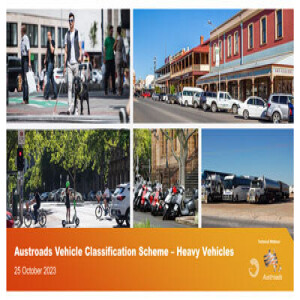
Wednesday Oct 25, 2023
Austroads Vehicle Classification Scheme – Heavy Vehicles
Wednesday Oct 25, 2023
Wednesday Oct 25, 2023
Austroads has developed an extended vehicle classification scheme (EVCS) to enable improved understanding and monitoring of the evolving vehicle mix on Australian and New Zealand roads in traffic and transport surveys. This builds upon the existing 1994 vehicle classification scheme.
The EVCS provides greater granularity for each of the existing 12 classes of vehicles and adds a new class for active transport to address the need to count a variety of active transport users such as pedestrians, skateboards and e-scooters.
The EVCS will allow transport agencies to better manage transport demand within and between modes, survey active transport and understand how demands integrate with other modes.
The scheme will help identify changes in transport operational performance and optimise plans for effective access management and asset maintenance.
This webinar, presented by Drew Gaynor and David Johnston, is the first session in a three-webinar series, and it focuses on the changes to heavy vehicles. The second webinar will cover light vehicles and the third session will provide information on measuring active transport.
This webinar discusses:
- level 3 classes 3 to 12
- the greater granularity in level 4 subclasses
- better description of axle groupings
- the creation of a new class 19 for heavy vehicles that do not fit readily into the prescribed classifications
- backward compatibility with existing heavy vehicles counting
- further validation of some sections.

Thursday Oct 19, 2023
Physical Infrastructure to Support Connected and Automated Vehicles
Thursday Oct 19, 2023
Thursday Oct 19, 2023
In this session, we will present a comprehensive report that identifies and explores those physical infrastructure practices that matter most to CAVs. Just like human drivers, CAVs need to understand line and pavement markings, electronic and non-electronic signs, and traffic signals. Computer sensing and computer processing, however, differ to humans, and differ between different and evolving systems used in Active Safety Systems (ASS), Advanced Driver Assistance Systems (ADAS), and Automated Driving Systems (ADS).
Drawing insights from a review of Austroads publications and latest research, this webinar uncovers the latest industry knowledge and physical infrastructure requirements. Discover the latest practices and standards, and where clear agreements have emerged, recommendations for effective changes will be unveiled. Furthermore, we examine areas where further study, monitoring, and industry engagement are needed, ensuring a holistic approach to accommodating future developments.
This webinar helps agency decision-makers preparing for future physical infrastructure CAV support practices. The knowledge presented in this report is based on robust evidence and expert opinions, providing a snapshot of the current landscape while remaining adaptable to the evolving CAV industry and its technological advancements.

Thursday Oct 05, 2023
Update to the Guide to Road Design – Detailed Review of Supplements
Thursday Oct 05, 2023
Thursday Oct 05, 2023
Supplements have provided important additional guidance to the Austroads Guide to Road Design (Guide). But there are questions about their use. Are these supplements needed? What should they contain? Should the information in the agency supplements be included in the Guide? These questions were addressed in a recently completed Austroads project that undertook a detailed review of jurisdictional supplements to the Guide.
This webinar describes the classification of material in the jurisdictional supplements to establish guidance that could be moved into the Guide.
The sessions focuses on a cross-jurisdictional platform for managing supplements within a jurisdiction and moving information from supplements to the Guide. The platform was developed with the input from the Project Control Group and the Road Design Task Force represented by Australian and New Zealand road agencies, and the Australian Local Government Association.
The platform uses a ‘push-pull” approach where Austroads looks to ‘pull’ information from the supplements, and the road agencies look for a means to ‘push’ information into the Guide. This approach aims to assist in minimising supplement content and harmonising material in the Guide.
The webinar was presented by Dr Rod Troutbeck, Dr Hafez Alavi, Mark Lenske and Phil Rosser.
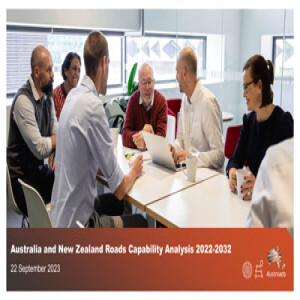
Friday Sep 22, 2023
Australia and New Zealand Roads Capability Analysis 2022-2032
Friday Sep 22, 2023
Friday Sep 22, 2023
Following previous workforce capability studies undertaken in 2006, 2009, 2013 and 2017, Austroads engaged Oxford Economics Australia to undertake a new workforce capability analysis for member authorities based on planned and forecasted infrastructure development and service objective requirements in Australia and New Zealand over the next 10 years to 2032.
Through stakeholder and industry engagement – as well as gap analysis including extensive data analytics – this analysis seeks to explain how skills demand will form for road agencies over the coming decade, what will be the key threats to workforce capability in the roads sector, and what road agencies can do to respond to the challenges ahead.
The study identifies which jurisdictions are expected to experience capability gaps in the next five years and stresses the importance of implementing measures to attract and retain skills, particularly given competitive threats from rising activity in other sectors over the coming decade.
New to this iteration of the study is the provision of quantitative data through interactive dashboards which allow users to focus on specific skills and occupation profiles in each jurisdiction. These dashboards will be updated with new workforce data and forecasts through 2024 and 2025.
This webinar, presented by Adrian Hart and Thomas Creevey from Oxford Economics Australia, provides a summary of the results and findings of this research. The session covers the following:
- current breakdowns of the roads skilled workforce in Australia and New Zealand
- state of play and outlook for roads activities and skills demand
- insights from industry survey and interviews on existing capability concerns
- how the roads industry can respond positively to the workforce skills challenge
- what information the new dashboards contain and how they work.

